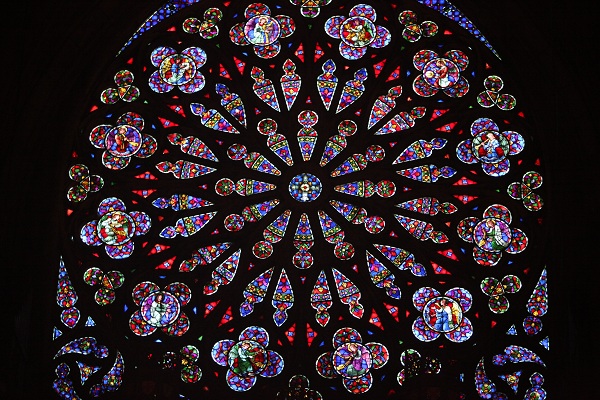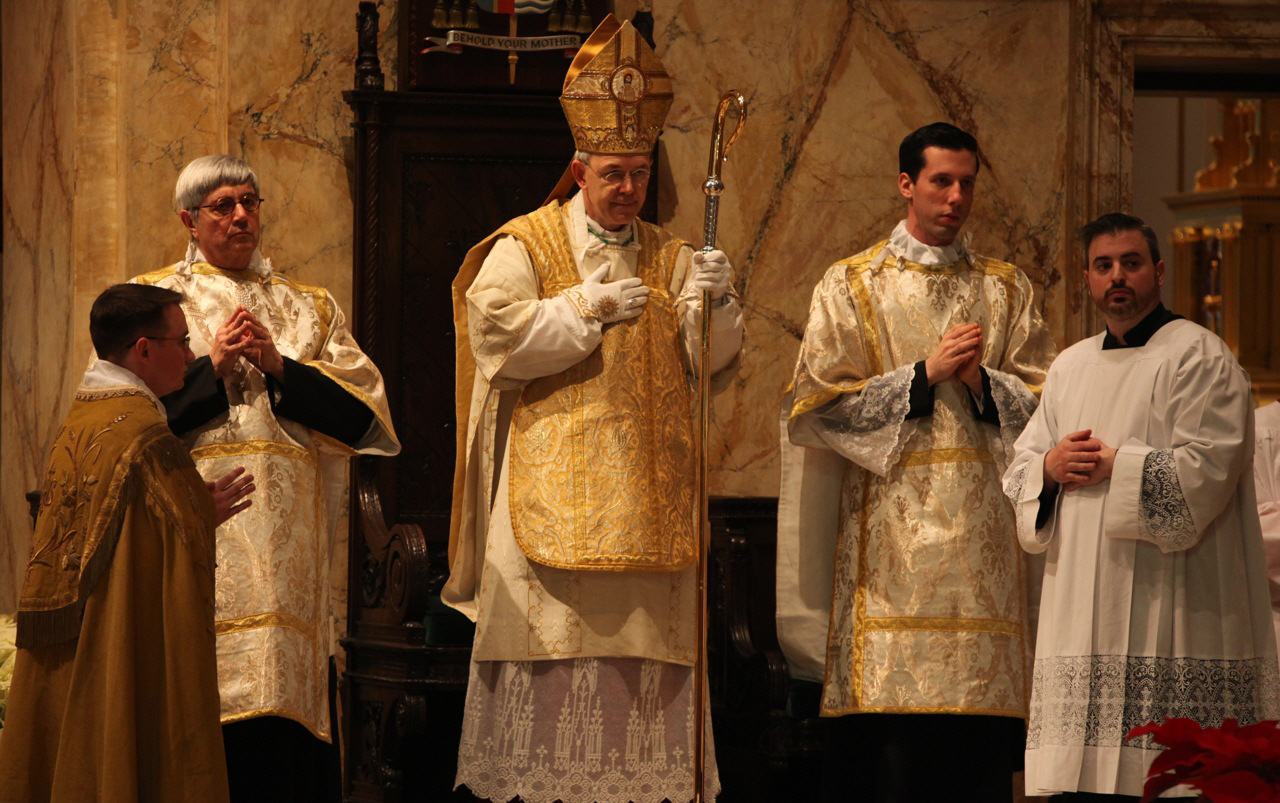This past Sunday, St. Mary Church, Norwalk, CT held its annual Corpus Christi Mass and procession.
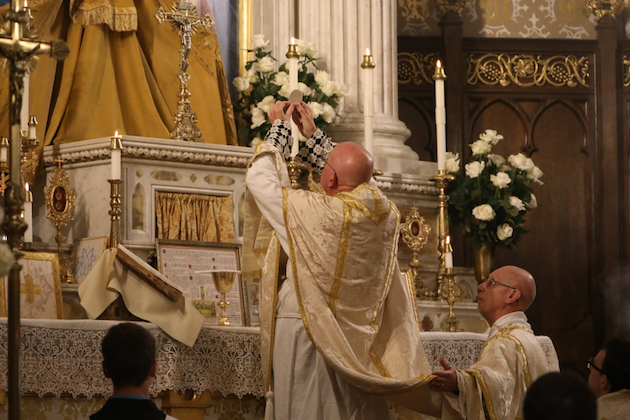
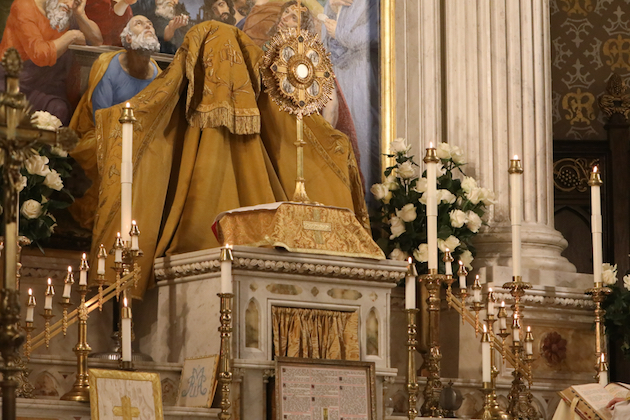

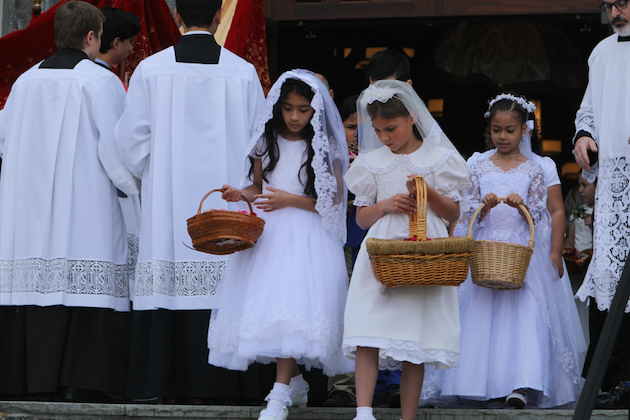
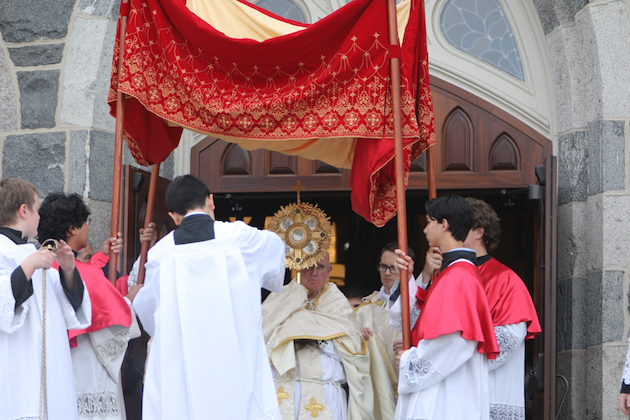
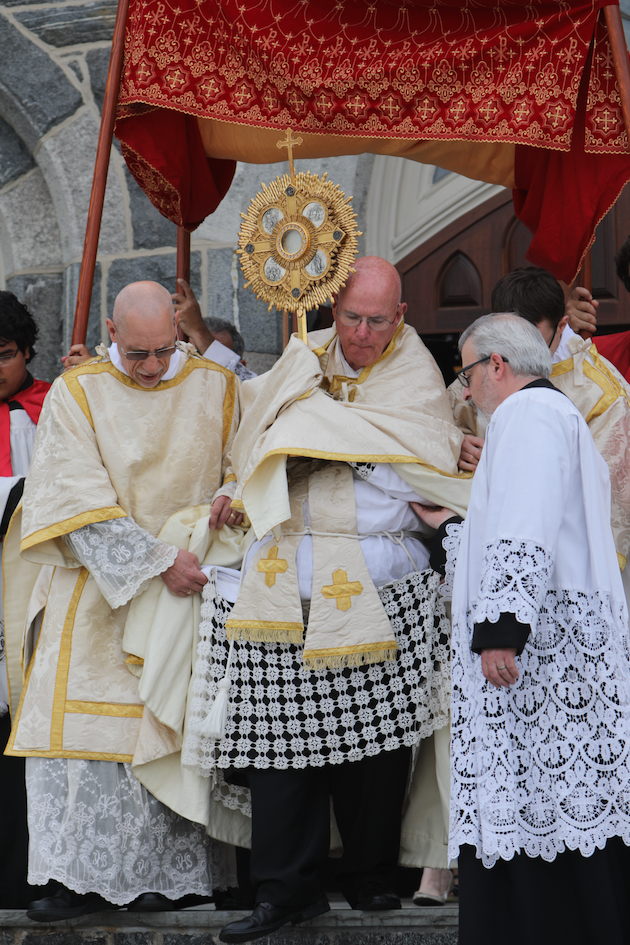
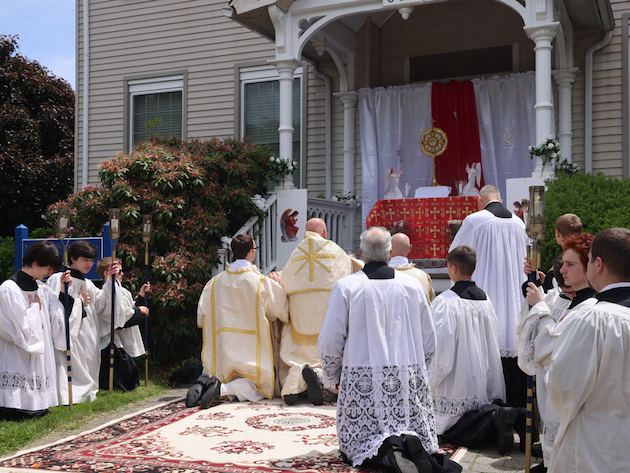

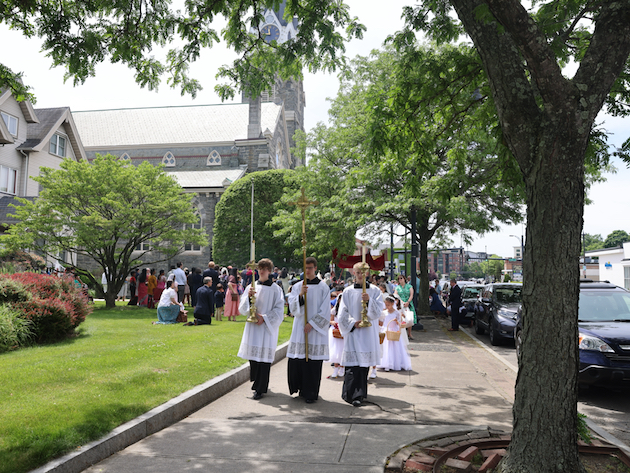
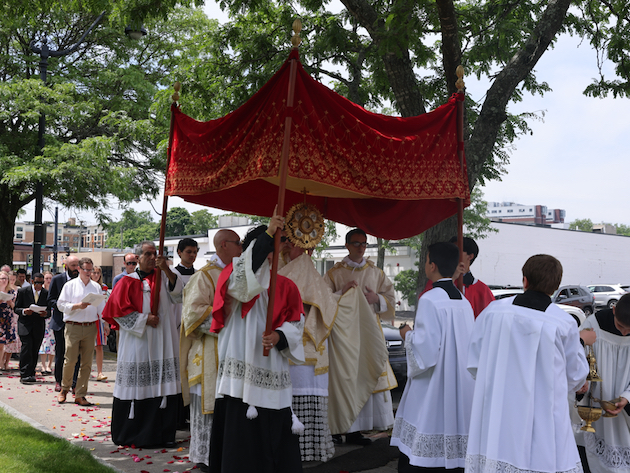

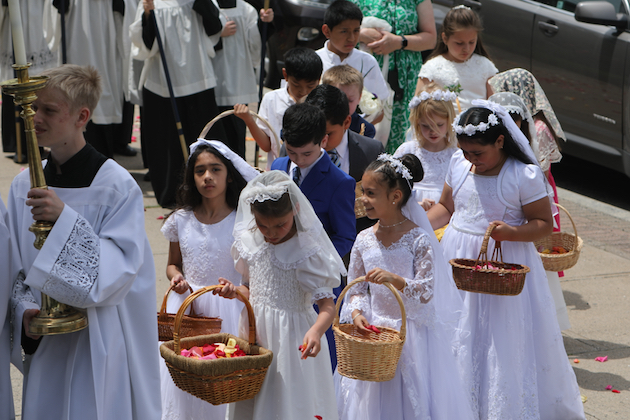
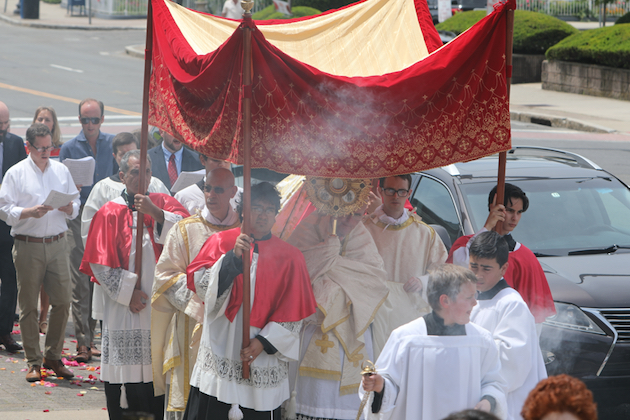
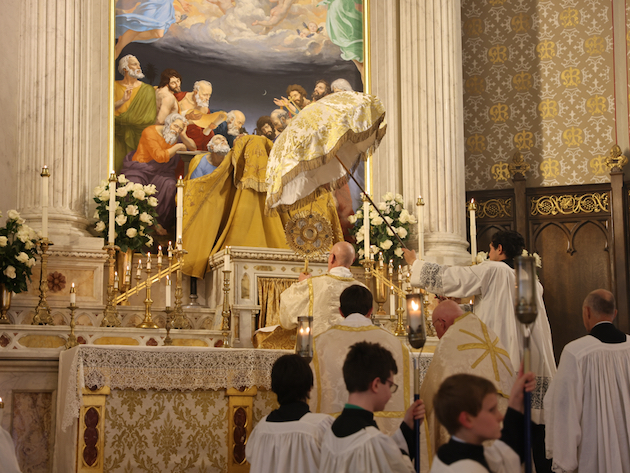
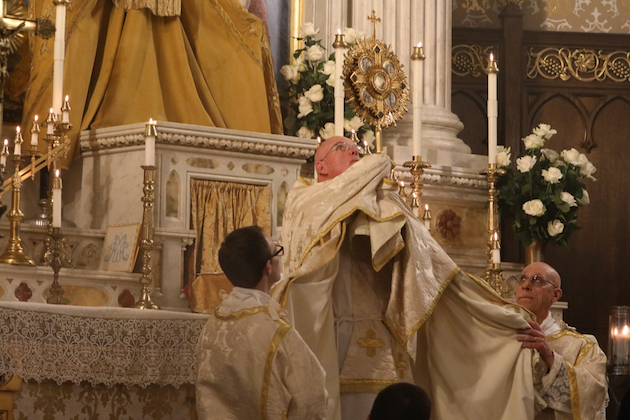


Sermon for Trinity Sunday 26 May 2024
Fortieth Anniversary of Ordination to the Sacred Priesthood
From St Paul’s Epistle to the Romans:
“And this hope will not leave us disappointed, because the love of God has been
poured out in our hearts through the Holy Spirit who has been given to us.”
But it seems that something has happened that has never happened before: though we
know not just when or how or where.
Men have left GOD not for other gods, they say, but for no god: and this has never
happened before.
That men both deny gods and worship gods, professing first Reason,
And then Money, and Power, and what they call Life, or Race, or Dialectic.
It is this passage from T.S. Eliot’s “Choruses from the Rock” that describes the
current situation of man in this present age. And Eliot is correct: this has never
happened before. Human history is characterized by the awareness of the sacred,
however that awareness has taken form. It has always been a given. But something
has happened in this time: men have left God not for other gods but for no god. But,
the answer swiftly comes: “All the polls show that the great majority of Americans
say that they are religious”. The liberal press is fond of trumpeting the rise of
professed atheism, but most people would describe themselves as religious in some
way. But because people say that they in some sense believe in God, does not mean
that for all practical purposes this belief is not in fact a form of atheism, for if you go
on to question them about this god and their relationship to this god, you discover–
and this is true about many religious people who even attend church– that this god
is a mental, subjective construct who plays no role in their lives. For this is a god
who has to fit into the post- modern way of looking at things. And what is this way
of looking at things?
First of all, we measure worth, the ultimate measure and worth of man, by the
notion of success, and this success has to be IN something, and something that can
be seen. We can deny that this is how we see things, but it is true. It is part of the
very air we breathe. And this is something new—oh, not that new—but new in the
sense that this way of looking at the worth of man replaced the older one that held
up the saint as the measure and destiny of man. For most of Western history people
looked to the saint as the measure of what it means to be a human being, as what
marked his possibilities. We, however, look to success in worldly endeavors as the
mark of man, sometimes even suggesting that the one who does “great deeds’ on
earth will go on to do even greater things in heaven. The Divo, the self made man,
the man who is successful in whatever field, the Divo—or to be more inclusive—the
Diva—has replaced the saints. And again, let us not fool ourselves about our
complicity in all of this. What is the content of our hope for our children? How
many of us deeply and consciously hope not for their success and freedom from
want but rather that they become like St. Paul or St. Perpetua or St. Thomas More?
Do we not rather hope for their success, leaving to them not a legacy of faith but
rather enough money so they can be comfortable? And in the process almost ensure
that they will never become saints. Those who looked to sanctity built cathedrals;
we build portfolios.
When the Divo replaces the saint, then God is not so much denied as pushed to a
place outside of the world, for it is in the world that we define our worth and our
destiny in terms of ourselves. We turn to nature to make sense of where our
creative energies come from, what enables us to be successful in whatever we do. It
is the “natural”, then, that in its own way becomes a god, but a god to be explored by
physical science, by psychology, by sociology, where scientific breakthroughs elicit
our admiration, where instincts and drives define what is natural and therefore
good. All human acts that are defined as natural, that is, instinctual, and feel good
are defined as good. Ethics is then turned on its head as abortion and euthanasia, as
well as random sex, become rights for the good of the individual. Human sexuality
itself is denied as being too exclusive and is replaced by the term gender. In those
years of my teaching career when I was blessed to teach AP Latin, part of the
syllabus were the poems of Catullus and Ovid, two masters not only of poetry but of
the exuberance of human sexuality. I imparted this knowledge to these very fine
students: nouns have gender. People have sex. And it is no wonder that in this
situation the Christian God who is a God who says yes or no, who prunes human
instinct, who can even contradict the impetus of nature, a God who demands
obedience to the moral law, and all in the name of love: this God must be banished.
And the banishment of God is nothing other than the banishment of, the deliberate
forgetting of sin—immemor peccatorum. But what else can we expect from the Divo
who is his own measure?
But the Divo is not content with glorifying instinct and feeling and naturalism. He
knows, because he is intelligent, that there is something wrong with nature, that
there is still famine and disease, there is still war, there is still suffering, there is still
death. And so the Divo uses his reason and sees that he can uncover the laws of
nature, that he can perform experiments that give him insight into how nature
works, and he then imagines that he can carry this all the way: that he can
manipulate nature, change it, and bend it according to his will and his will is his own
personal happiness, which may or may not coincide with the happiness of his
neighbor. He sees himself as the true master of his life, of his own destiny, able to
perform genetic manipulation to ensure perfection, able to clone this perfection to
eliminate all imperfection in human nature: the Divo as dominus, the Divo as lord,
the Divo as he who needs no God, the Divo who protests that he is religious., that he
believes in a god, but his very life, whose very context in which he chooses to live
that life, is a life lived in isolation, where relationships become painful
impossibilities, the Divo who so marginalizes God that even if He existed it would
not matter.
This is the situation in which this Trinity Sunday must be celebrated. One is
tempted to say nothing or say something about a shamrock or say something about
peace and love and call it a day, a day on which it becomes more and more difficult
to say anything at all. For to speak of the Christian God to a world that has banished
him for all practical purposes is to run the risk of unintelligibility, or, as is more
common, the risk of incurring the wrath of the Divi and the Dive who are made
uncomfortable by the presence of the living God who cannot be banished to a
mythical heaven, for this God is the God who loved the world so much—loved, had a
relationship with –that he gave his only-begotten Son to die on the cross to forgive
our sins, who rose again on the third day to triumph over death and who has poured
his Love into our hearts in the Person of the Holy Spirit who has been given to us.
What sense can this make to the Divo asks the one in despair at the situation of the
contemporary world? The answer is and always has been: Yes, it makes absolute
sense. For no one but the true God can resonate with what is real. And that is what
this age is searching for—yes, even the Divo searches–, and if post-modern man has
turned away from the light of reality and has chosen to live in the darkness of a
disneyfied and closed -in -on- itself world, the hole in his heart is still there: the
ache, the longing, the thirst. This is part of who we are. And it is the light of the
ineffable Trinity, the God who is Father, Son, and Holy Spirit, not as some abstruse
doctrine, but the God who is experienced as the Creator who gives being, the God of
Abraham, Isaac, and Jacob. the Author of all life, the Father who reaches out of his
infinity to the other, reaches out in love. The God who is Son, who is experienced as
God with us, the God who does not stand apart and aloof but who enters, becomes
part of our human history, the God who takes his flesh, our flesh, from the Virgin
Mary, –et incarnatus est–the God who is born in a manger, the God who plumbs the
very depths of human suffering, the God who is spat upon and mocked, the God who
is stripped, the God who endures pro nobis the shame of the Cross, whose death rips
through the universe, exposing the father of lies who can no longer hide in the
darkness, the God who is with us at the time when the Divo knows he is alone, in
the hour of death, when the horrible reality of sin threatens me with absolute death,
extinction, blackness, He is with us, embracing us, hiding us in his wounds, the
wounds of life. Christ is with us at this Mass, not in some abstract way but in a real
way, no mere symbol –Hoc est enim corpus meum–his beauty shining forth in the
beauty of the of this Mass, where heaven and earth meet and once again Beauty
gives himself to save the world.
The God with us who is the Holy Spirit, whose existence is a fact in this world, and
that fact is the Church, the God who is not confined by any space or place but who
breathes where He wills, but who in-forms the Church, the place where sins are
forgiven, where the Food of Life is eaten and drunk, the place where God is seen to
act in human history, where the fullness of truth subsists and where that truth can
be put into human words and where that truth can be understood, where that truth
can be heard with the ears and accepted by the mind and heart that recognizes that
truth and leaps for joy, a joy that alone can penetrate the armor not only of the Divo,
but of you and me, a joy that melts the heart so that in its molten form, freed from
the crystal lattice of sin, it can love in that freedom that is that perfect freedom, the
freedom of God who is l’amor che move ‘l sole e l’altre stelle, the Love who moves
the sun and the stars.
Father Richard Gennaro Cipolla
31
May

It was under the Hohenstaufen emperors – primarily Frederick I, Henry VI and Frederick II – that the Holy Roman Empire achieved its greatest power and influence. Frederick I (1152-1190) battled in Italy to preserve imperial rights and died on the Third Crusade in Asia. Henry VI (1190 – 1197) may have been the most powerful and successful emperor. His marriage in 1186 to Constanza (Constance), the sole heiress of the crown of Sicily, united the empire with perhaps the wealthiest Kingdom in Europe: Sicily. It was the worst nightmare for the now surrounded papacy. Frederick II (1198-1250), the son of Henry and Constanza, dazzled Europe with his many accomplishments – in his day he was known as stupor mundi (wonder of the world). He warred for decades again the popes. Yet this war to the death with the papacy eventually fatally weakened the central power of the empire.
The Holy Roman Empire revolved around Germany from 962 to 1806. Yet, as a result of Henry VI’s marriage to Constance, the period after 1190 through much of the 13th century forms an exception. In this era Italy emerged as the new center of the empire. Frederick II ruled mainly from Sicily and Naples even though the kingdom of Sicily, as oppposed to Northern Italy, previously had never been considered part of the empire at all. Certainly the most enthusiastic partisans of the empire in the 13th century – the Ghibillines and similar parties – were now found south of the Alps. It took the papacy decades of war to eliminate the last of the Hohenstaufen (Manfred, Conradin) from the Italian peninsula.
This history is why today we stand in wonder before the magnificent porphyry sarcophagi of Henry VI and Fredrick II in a side chapel of the cathedral of far-off Palermo. These are perhaps the most magnificent tombs of Holy Roman emperors, carved in the same rare stone we also can still see in late Roman imperial sarcophagi especially in the Vatican museums but also in Constantinople. Thus, continuity was established with the Roman empirs prior to the coronation of Charlemagne in 800.










Yet it is fitting that these emperors rest here, so far from their ancestral home or even Northern Italy. For, after the accomplishments of Frederick I, it seemed that Henry VI was at last achieving the promise of the empire to restore the unity of Christendom. Within his own domains, the German princes and the Italian city states suspended their opposition to the expansion of Imperial authority. Even the papacy adopted an accomodating policy. Within Europe, England, Denmark, Hungary and others accepted Henry’s overlordship. And the union with the Kingdom of Sicily opened up unheard-of vistas of a truly worldwide realm. Henry forced the Byzantine emperor to pay tribute, his authority was acknowledged by the Armenian kingdom and the kingdom of Jerusalem. Henry in 11197 was assembing a mainly German army for a crusade in the East. But then he died, leaving an infant son (the future Frederick II). The laboriously constructed structures and relationships of his vast realm collapsed. The stability of the Holy Roman Empire depended far too much on the personality of the ruler. After Henry’s death, some 20 years of succession disputes followed in what, after all, always remained an elective monarchy. It was in this period that the papacy, under Innocent III reached the apogee of its power over Christendom.
Frederick II could only be crowned emperor in 1220. He had, if anything, even more exraordinary “charismatic” and intellectual gifts than his father or grandfather. Fantastic hopes and expectations surrounded him. Yet by the time Fredrick was able to exercise undisputed rule, the papacy, the Italian city states and the German princes – not to mention the kingdom of France – had all gained dramatically in power and influence. The result was an endless struggle with the popes and their allies – primarily in Italy – and the decline of the central power of the emperor. The body of Frederick II still reposes in the capital of the kingdom of Sicily, where he spent most of the later years of his life.
30
May
Today Regina Pacis Academy, the Catholic classical preK through 8 school in Norwalk, Connecticut celebrated the Feast of Corpus Christi with a Solemn Mass, Procession and triple Benediction at the church of St. Mary.

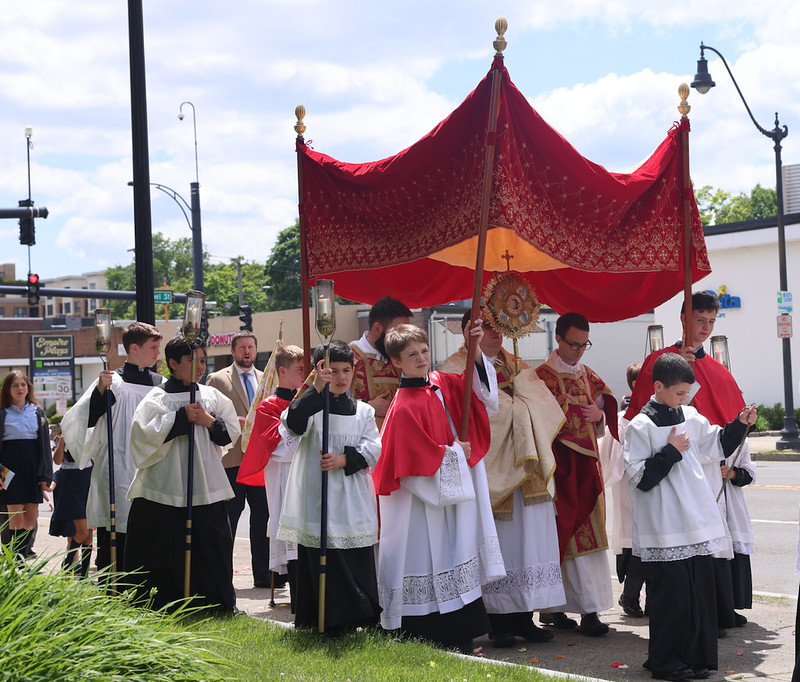
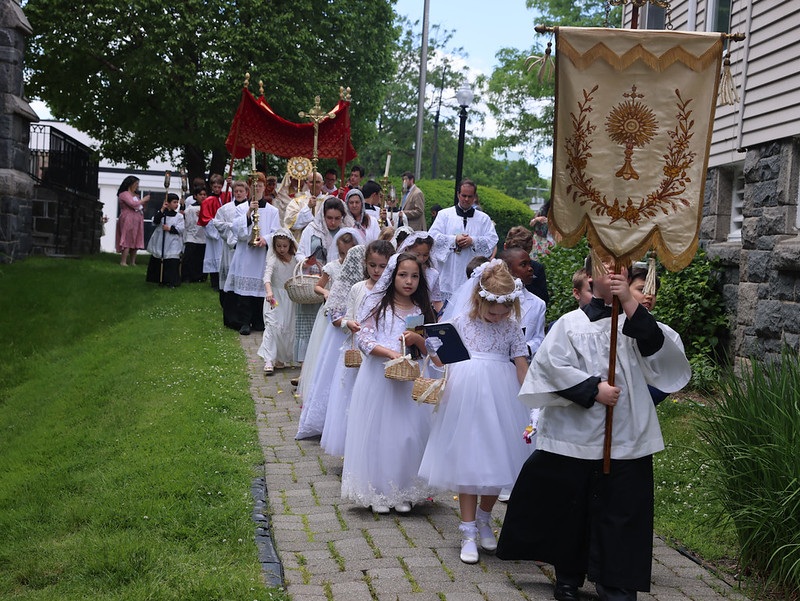

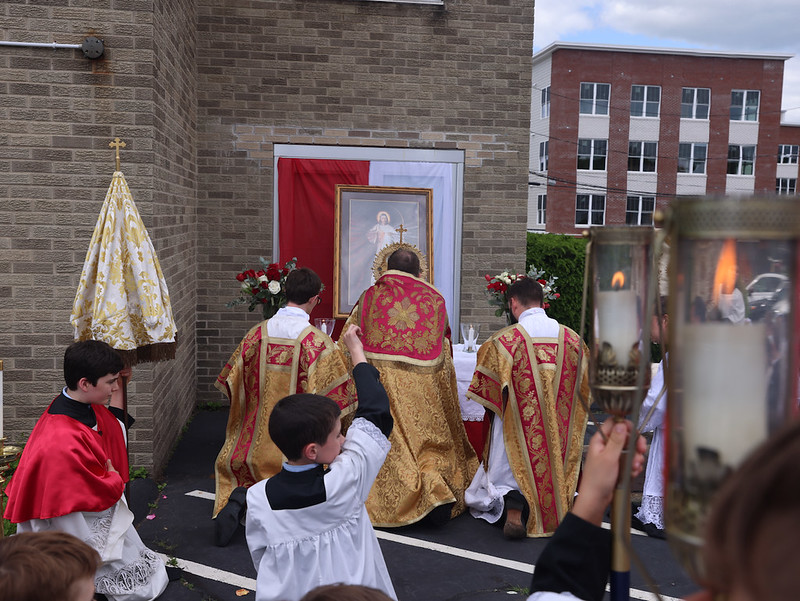

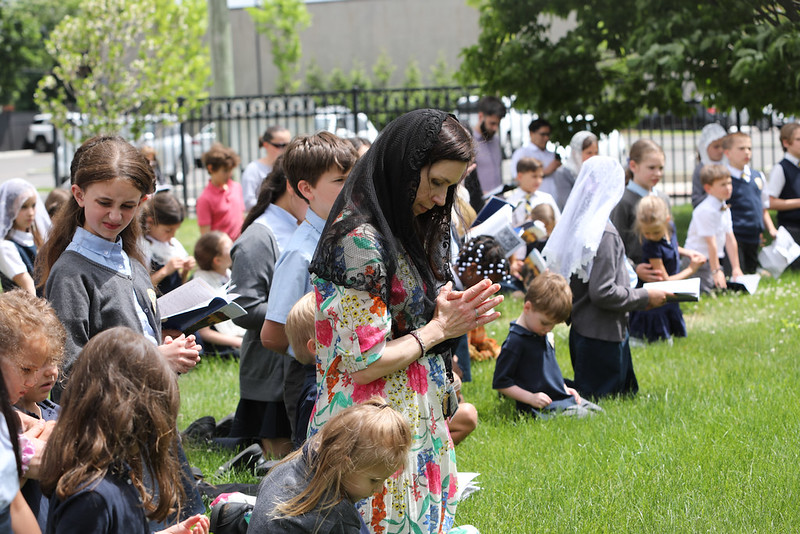
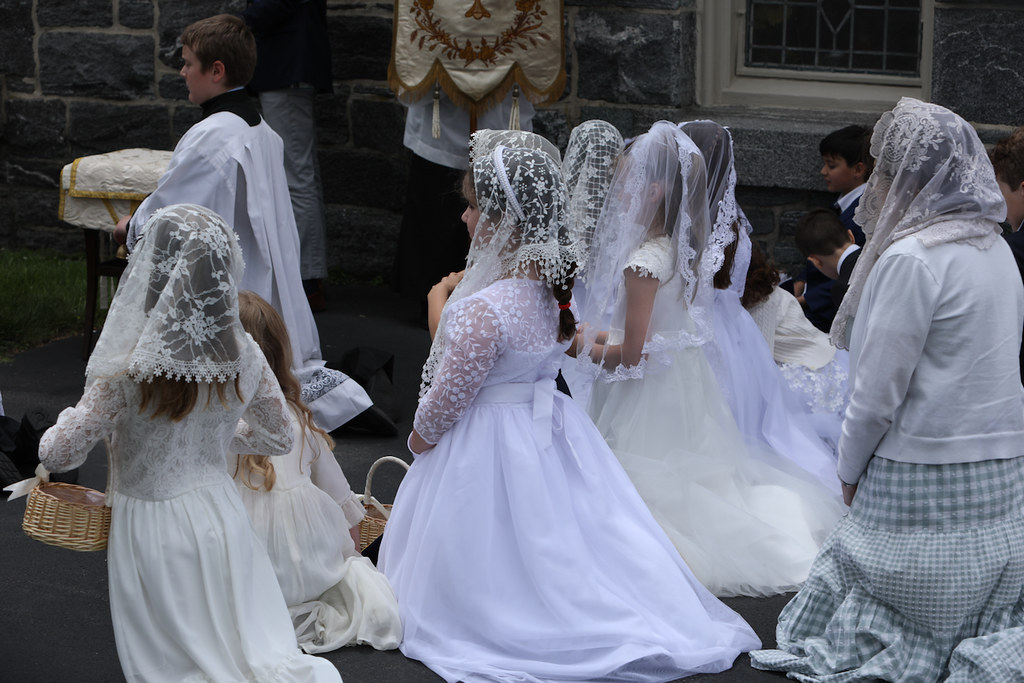
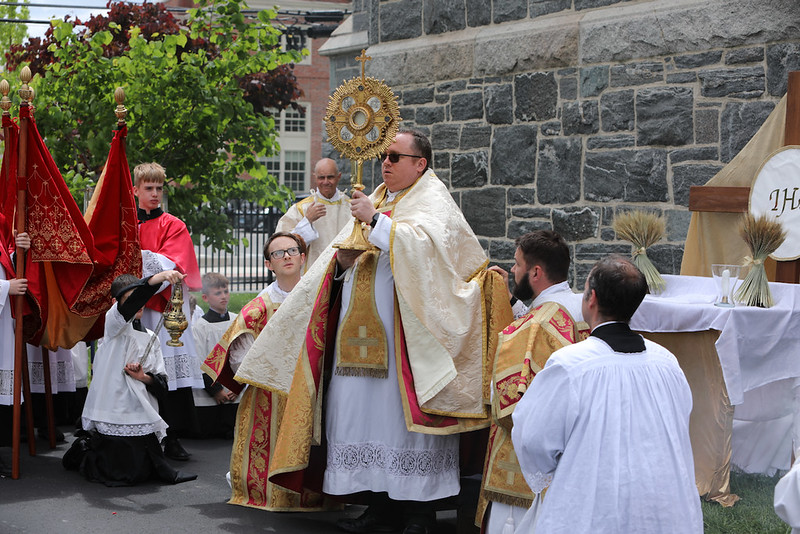
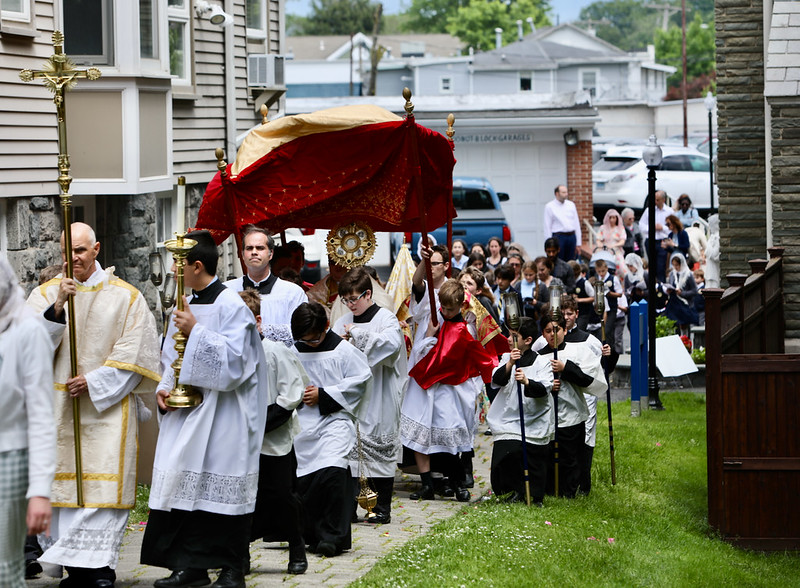
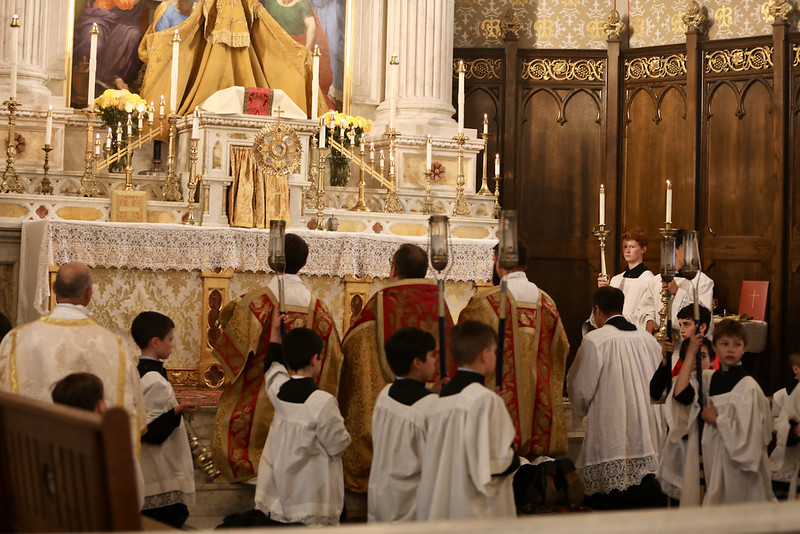
This past Sunday, Fr. Richard Cipolla celebrated his 40th anniversary as a priest at St. Mary’s in Norwalk with a Solemn Mass, attended by a large congregation.








28
May
28
May
28
May
Here is the schedule of TLMs for June 2024 (and 5/31) at the Shrine Chapel of the Blessed Sacrament.
Shrine Chapel of the Blessed Sacrament,50 W. Somerset Street, Raritan, NJ. More info: BlessedSacramentShrine.com

28
May
This Thursday, May 30, is the Feast of Corpus Christi. The following churches will offer Traditional Masses.
Thursday, May 30
St. Mary Church, Norwalk, CT, 12:10 pm, Solemn Mass and Eucharistic procession. Mass for 4 Voices by William Byrd
Sacred Heart Oratory, Georgetown, CT, 6 pm, Solemn Mass with procession and Benediction
St. Patrick Oratory, Waterbury, CT, 6 pm with procession of the Most Blessed Sacrament around the church building.
Sts. Cyril and Methodius, Bridgeport, CT, 6 pm, Solemn Mass and procession.
Holy Innocents Church, New York, NY, 6 pm, Missa Cantata followed by outdoor procession and triple Benediction
Most Holy Redeemer, New York, NY, 6 pm followed by Eucharistic procession to St. Brigid’s Church with Benediction.
Our Lady of Mount Carmel, New York, NY, 7 pm Solemn Mass; 8 pm Outdoor procession; 8:30 pm Benediction.
St Josaphat, Bayside, Queens, 7pm Missa Cantata followed by procession
St. Paul the Apostle, Yonkers, 12 noon
St. Andrew Church, Ellenville, NY, 7pm Missa Cantata
Our Lady of Sorrows, Jersey City, 7 pm
Our Lady of Fatima, Pequannock, NJ, 7 am, 9 am, 7 pm
St. Athony of Padua Oratory, West Orange, NJ, 9 am, Low Mass, 7 pm High Mass and procession
St. John the Baptist, Allentown, NJ, 7:00p.m. Mass followed by Eucharistic procession.
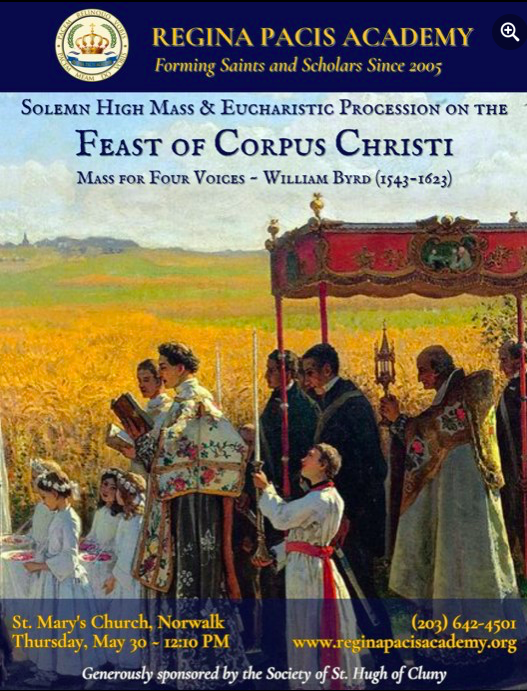
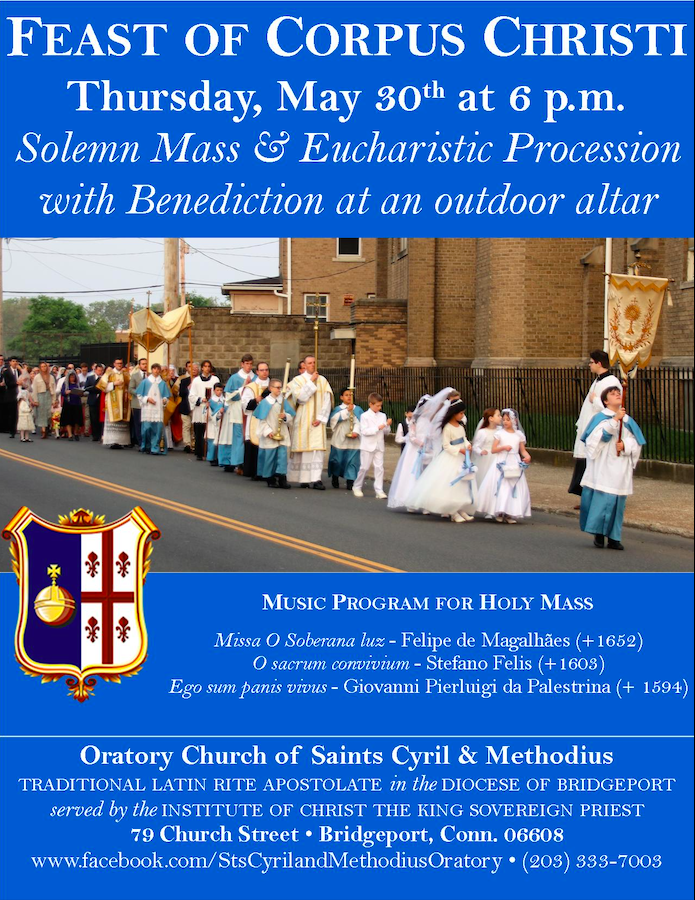

The archdiocese has published the decree of merger of St. John the Evangelist- Our Lady of Peace and Holy Family parishes. Holy Family will be the surviving parish:





This is the second time the parish has been terminated. 1) The first was in 1969, when the archdiocese demolished the original parish church of 1880 and in its place started construction of the New York Catholic Center – a small skyscraper housing the legion of Archdiocesan bureaucrats and a Catholic high school. We are fortunate to have a witness to these events who was also an active participant in this process. Monsignor George A. Kelly was Secretary for Education in the New York archdiocese and later the first pastor of the new St. John the Evangelist located within the Catholic Center. Monsignor Kelly is probably still best known for his 1979 book The Battle for the American Catholic Church, a seminal text for Conservative Catholicism.
Kelly’s The Parish: as seen from the Church of Saint John the Evangelist, New York City 1840-1973 (St. John’s University, NY 1973) is a work full of curious and valuable facts on the immediate post-conciliar era. The author, in the final two chapters dealing with the demolition of the old St. John the Evangelist and the building of the Catholic Center refers to himself in the third person. Much of what Kelly writes in justification of the archdiocesan actions is startlingly familiar:
Indeed, radical uprooting of old structures is sometimes required in the name of life. Many large churches, providing diminishing service, stand long after people have moved. And frittering away limited church resources on ancient forms when substantial new needs existed in other places, is not good sense, if only because of the unreasonable amount of priest power and money power locked into ecclesiastical enterprises no longer productive. (p. 123)
But ideological and theological rationales also justified the decision:
Moreover, liturgical changes have made 19th century churches less than useful to 21st century needs. … When Father Flood was building the 1880 church, some judged 1,200 seats too few. Today cathedral-like churches are hindrances to the eucharistic community and 200 people scattered throughout a nave built to sit six times that number give the church the appearance of a museum, not a dynamic house of worship. (p.123)
I was thus intrigued to find explicitly stated in Kelly’s book many of the things I had surmised from the location, décor and architecture of the new St. John the Evangelist. Of course, whether these arguments were meant seriously or were merely excuses to justify an essentially financial transaction I will leave to the reader to decide. Kelly himself describes a real estate transaction involving Cathedral High School proceeding in parallel with the closure and demolition of old St. John’s. Here too ideological arguments were adduced to locate this school in an affluent area.
Of course, on Monsignor Kelly’s own evidence, St. John’s was, up to the Second Vatican Council and even afterwards, not a moribund parish at all. Attendance had leveled off over the decades, but strangely the parish income steadily increased because of the continued development of nearby Sutton Place. There was still a functioning school. Indeed, by 2024 standards, St. John’s in 1969 looked distinctly healthy!
The parishioners did not at all agree with the decision to demolish their church. From reading Kelly’s book and from other sources, opposition seems to have been fierce and the process traumatic. Kelly describes the laity of the parish as ignorant and emotional:
While the decision was supported by an array of substantial arguments in its favor, those directly affected, especially the parents of school children, were distressed and angry. (pp. 125-126)
In this book we thus have yet another witness to the contempt of the post-conciliar clergy for the laity (which continues to the present day). And of course, this comes from the pen of a “conservative,” not a radical reformer!
Archbishop Cooke, despite his ineffectual, Pope Paul VI-like persona, could, just like the Pope, take drastic action against those who were seen standing in the way of progress. The parish was duly closed, and the construction of the new building began. St. John’s parish virtually ceased to exist:
(O)nly one third of (the) number (of parishioners)remained after the demolition of the old church in 1969 to offer mass in a very unattractive chapel situated on the ground floor of a solid but hardly well-appointed rectory. Sunday attendance was down to 700 and there was little call for baptism, matrimony, penance, extreme unction, indeed for any substantial priestly service. All parish organizations were moribund and total parish income fell between 1969 and 1970 from $223,000 to approximately $106,000. (p.135)
Kelly then describes what he audaciously calls the “Fifth Spring of the Parish.” St. John’s had to start all over again “as if it were 1840.” Kelly writes that “1973 not only marks the end of four years of stress and unhappiness but hopefully the beginning of a new parochial dream.” (p. 135) Kelly’s confidence in the future, however, seems to have been tentative, even shaky, based more on ideology and wishful thinking than facts:
“In spite of a sense of loss for the old, a new church might be more salvific for the future. … Not every parishioner would agree with this, and time may yet prove their judgment correct.” (p. 137)
“What may be expected of the new parish of Saint John’s will only be known after the more commodious and properly appointed facilities of the new church are completed and are available for use.” (p.145).
“There is no great rush to utilize the parish facilities as yet. Only time will tell whether St. John’s will survive as a neighborhood parish.” (p.142)
Did parish life survive after 1973 or, as Kelly feared, did the new church simply become a chapel for the school and the archdiocesan employees? I do not know enough about the post-1973 history to say. Over the years, however, an array of figurative art was added to soften the original, radical decorative scheme of Kelly’s time. In 2014, the (relatively)nearby parish of Our Lady of Peace was merged into St. John’s. Within two years the church building of Our Lady of Peace was sold. That does not bode well for the continued existence of the “worship space” of the former parish of St. John’s, once the last archdiocesan offices vacate the Catholic Center in 2025.
St John’s is one of the earliest examples in New York of a parish restructuring/closure, directed from the top, and also of a new Novus Ordo worship environment. Monsignor Kelly wrote thst only time would tell how successful the newborn parish would be. Now, in 2024, we do know the answer: the new St. John’s was an abysmal failure ending in its dissolution.
On the parish church of St. John the Evangeliset see our post. On the looming fate of the archdiocesan headquarters see HERE.
